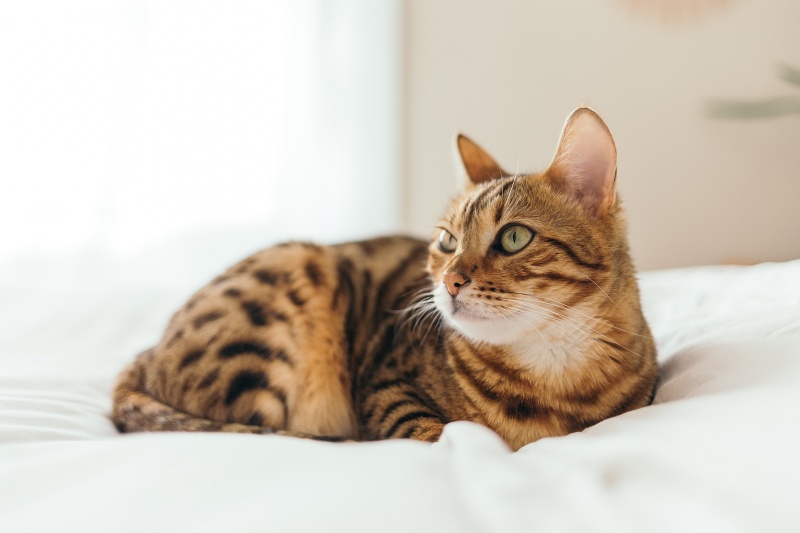Radiodine I-131

Hyperthyroidism is a disorder caused by excess thyroid hormone in the bloodstream and body.
It is the most common hormonal disorder in domestic cats. The same treatment options that exist in humans exist in cats.
These treatment options include:
- Medication to suppress the thyroid hormone
- Surgical removal of the thyroid tumor
- Feeding a life-long low-iodine commercial diet
- Radioactive Iodine (Radioiodine I-131) therapy to destroy the thyroid tumor. Radioiodine I-131 is the treatment of choice because it is effective and a safe cure regardless of your cat’s age. If left untreated, however, hyperthyroidism can be fatal.
What is Hyperthyroidism?
Hyperthyroidism is an excessive amount of circulating thyroid hormone in the bloodstream. It is seen in middle-aged to geriatric cats. It is caused by one or more benign tumors of the thyroid gland. Occasionally a carcinoma (cancer) is a very rare cause of hyperthyroidism we see. The most common finding is weight loss due to an increased rate of metabolism. Cats will tend to eat more (sometimes having a ravenous appetite). Weight loss can sometimes be quick or gradual. Other signs include anxiety, nervousness, increased heart rate, vomiting, diarrhea, increased thirst and urination, panting, and sometimes a poor hair coat. Over time if left untreated, hyperthyroidism can have effects on internal organs such as the liver, kidneys, and muscles. Hyperthyroidism is easy to diagnose by your veterinarian based on history, physical, and routine blood tests.
How is Hyperthyroidism Treated?
Hyperthroidism can be treated medically, surgically, by feeding a lifelong low-iodine diet, or Radioactive Iodine. Medical treatment consists of administering a medication called methimazole once or two times daily. This medication helps control clinical signs but is not a cure. The drug blocks thyroid secretion but does not destroy or remove a thyroid tumor. The thyroid will continue to grow while on methimazole. Many cats will develop large thyroid tumors and some will undergo malignant transformation into thyroid carcinomas (cancer). Feeding a low-iodine diet can work but does not destroy the thyroid tumor. The commercially available diet (Hill’s y/d) is sometimes not very palatable and is lower in protein which can sometimes be problematic for cats that require a higher protein diet. Surgery is a cure but can result in severe post-operative complications such as hypocalcemia. Radioiodine (I-131) is a cure. This is simple, it is safe, and is a single subcutaneous injection of Radioiodine (I-131).
Why is Radioiodine Preferred Instead of Medicine or Surgery?
Radioiodine-I-131 has a distinct advantage and is the treatment of choice for treating hyperthyroidism. There is no need for anesthesia and post-operative risks from surgery are avoided. No medicine is needed and the only major downside is that your cat will stay in the hospital for a few days (usually 3-5 days). Overall I-131 is a simple, effective, and safe cure.
How Does Radioiodine Work?
Normal thyroid function requires iodine. Iodine is part of our everyday diet and is commonly added to salt. When iodine is ingested, the thyroid gland takes up the iodine. Here the iodine becomes incorporated into the thyroid hormone. When your cat receives radioactive iodine, the tumor in the thyroid uptakes the radioactive iodine much like it does normal orally ingested iodine. All of the thyroid tumors will take up the radioactive iodine. Once all of the tumors uptakes to I-131, the radioiodine starts emitting radiation, destroying the overactive thyroid tumor cells. A hyperactive thyroid tumor suppresses the function of any normal thyroid tissue. The normal thyroid cells will therefore not take up any radioactive iodine. This is very important meaning that cats rarely develop an underactive thyroid gland (hypothyroidism) after radioiodine therapy. After treatment, the normal thyroid tissue will regain full function within 1-3 months. The average cure rate using I-131 is 98% resulting in a safe, effective cure with one single injection.
Is My Cat Too Old for Radioiodine Treatment?
Hyperthyroidism in cats can be treated at any age as long as there are no other life-threatening diseases present. In order to make sure no other problems are seen, a number of screening tests may be done prior to treatment.
Making an Appointment and Preparing Your Cat for Radioiodine Treatment
How Do I Make an Appointment for This Treatment?
Please ask your veterinarian to send us, by fax or email, a patient referral form (this will be highlighted and they can click on for the form), together with the results of your cat’s history, physical examination, serum T4 level, and any routine bloodwork.
All of the routine blood tests must have been done within 1 month prior to treatment.
This routine bloodwork can be done while your cat is on (or off) methimazole.
Since hyperthyroid cats commonly develop secondary heart disease, a chest x-ray is required in all cats that were first diagnosed longer than 6 months.
If other abnormalities are present such as chronic diarrhea, vomiting, an abdominal ultrasound is strongly recommended to rule out other disease processes.
What Should I Do to Prepare My Cat at Home in the Week Prior to Treatment?
If your cat has been treated with methimazole (Tapazole, Felimazole) your cat needs to be off the drug for at least 7 days prior to treatment.
If you or your veterinarian feels your cat’s hyperthyroidism is too severe to discontinue medication, please have your veterinarian contact us to discuss other options.
Treatment Stay During Radioiodine Treatment
How Long is the Hospital Stay During Treatment?
The length of stay can vary from cat to cat. We measure the amount of radioactivity emitted by your cat’s thyroid everyday to make sure the thyroid has adequate radioiodine to be effective. By measuring the amount of radioiodine emitted, this will let us know when your cat can be discharged. The length of stay varies from 3 to 5 days.
Can I Check on My Cat During Their Stay?
Our entire staff is committed to ensuring your cat has the best stay possible. Attention to detail is ensured. Please feel free to call us anytime to check on your furry feline.
Can I Visit My Cat During Their Stay?
Unfortunately, we can’t allow you to visit during the stay because of the potential for radiation exposure. We will be happy to send you a picture or video during their stay.
Are There Any Side Effects or Risks With Radioiodine?
There are almost no side effects from radioiodine treatment. When your cat returns home, there may be a readjustment period while your cat’s thyroid returns to normal function. Your cat may be quieter and less active . This is due to the metabolic rate returning to normal. Your cat will regain the weight that was lost and his appetite will return to normal and not eat as much as before when he/she was hyperthyroid.
Should I Bring Anything for My Cat?
Please feel free to bring any toys, food, etc. with your cat during their stay for radioiodine treatment. We discourage this because anything that is brought into the radioiodine treatment room must not leave and will not be sent home with your cat.
What Happens When My Cat is Discharged From Treatment?
When your cat’s radioactivity level is below the legal limit to send home, we will contact you to make an appointment for discharge. We will review with you what precautions that you should expect over the following two weeks.
Initial At-Home Care for Your Cat Treated With Radioiodine
What Precautions Should I Take Initially When My Cat Comes Home?
Upon discharge, your cat will be minimally radioactive. The level of radioactivity is much lower that when human patients are discharged.
Please take the following precautions:
- You can play with your cat and cuddle but limit this time to about 20 minutes/day for 7 days.
- A safe distance for your cat throughout the day is at arm’s length.
- Do not let your cat be on your bed while sleeping.
- Do not let your cat be near children or pregnant women.
What Do I Need to Do With My Cat’s Litter?
Most of the radioactive material is excreted in the feces and urine. For the first 2 weeks, we advise flushing your cat’s litter in the toilet (make sure you use flushable litter). We also advise wearing gloves during this time.
If flushing the litter is not possible, we advise storing the litter in a container for 3 months to allow the decay of radioactive litter. (If you have any questions about this please don’t hesitate to contact us).
These Precautions Seem Like My Cat is Hazardous to Me. How Dangerous is the Radiation?
The amount of radiation your cat may be emitting is very low. The amount of radiation you might receive from your cat is roughly equivalent to that received when you fly round-trip across the country.
Human patients receiving radioiodine therapy can receive up to 10 times the amount of radiation cats do and still go home the day they are treated. The majority of the radioiodine in urine and feces your cat excretes is while your cat is staying with us.
While these discharge instructions seem alarming, these are extremely cautious and conservative. If you follow our instructions, you and your family will receive almost no exposure at all.
How Soon Will My Cat Return to Normal?
Your cat’s behavior will change within a few weeks. Some cats require 2-3 months for all the clinical signs to return to normal. Your cat will become calmer, gain weight, have better grooming, vomiting will stop, and less drinking and less urinating.
Should My Cat’s Thyroid Be Tested After Radioiodine Treatment?
We recommend monitoring at 1 and 3 months after treatment.
We will test a T4 level at that time.
At 6 months we recommend that all cats have a complete thyroid profile (T4, T3, free T4, and TSH level).
Cookies on this website are used to both support the function and performance of the site, and also for marketing purposes, including personalizing content and tailoring advertising to your interests. To manage marketing cookies on this website, please select the button that indicates your preferences. More information can be found in our privacy policy here.


